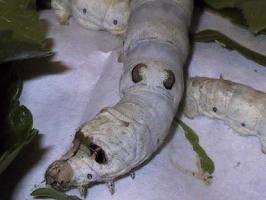
Állatleírás
The domestic silk moth, scientifically known as Bombyx mori, is an insect deeply intertwined with human history, culture, and economy due to its crucial role in the production of silk. This moth, belonging to the family Bombycidae, has been domesticated for thousands of years, with its origins tracing back to China around 5000 years ago. Unlike its wild ancestors, the domestic silk moth is a product of intensive selective breeding, which has led to a creature entirely dependent on humans for survival.Physical Characteristics:
The adult Bombyx mori is relatively modest in appearance compared to its vibrant and colorful wild counterparts. The moth exhibits a creamy white color, with a body that is plump and somewhat hairy. The wings are large but the moth is incapable of flight, a trait lost through the process of domestication. Males are generally smaller than females and can be distinguished by their more slender bodies and larger, feathery antennae, which they use to detect pheromones released by females.
Lifecycle:
The lifecycle of the Bombyx mori is a fascinating process that has been fine-tuned for the production of silk. It begins with the laying of eggs by a female, which are about the size of small pinheads and are laid in clusters. After approximately 10 days, these eggs hatch into larvae, known as silkworms, which are voracious eaters with a strong preference for the leaves of the mulberry tree. The silkworms go through five instar phases, molting between each phase, and significantly increasing in size.
After the final molting stage, the silkworms begin the process of spinning their cocoon, a laborious task that takes several days. During this time, the silkworm secretes a continuous filament of silk from its salivary glands, forming a protective cocoon around itself. This silk filament, which can be up to 900 meters in length, is the raw material for silk fabric. Inside the cocoon, the larva transforms into a pupa, and after about two weeks, emerges as an adult moth to complete the lifecycle. However, in silk production, the cocoon is often boiled with the larva still inside to preserve the integrity of the silk filament, preventing the moth from emerging.
Ecology and Behavior:
Bombyx mori has been completely domesticated and does not exist in the wild. Its entire lifecycle is managed by humans, from the cultivation of mulberry trees for feed to the controlled environment in which they are raised. The domestic silk moth is entirely dependent on human care, lacking the ability to seek food or evade predators.
Economic and Cultural Significance:
The domestic silk moth has immense economic and cultural significance. Silk produced from the cocoons of Bombyx mori has been a highly prized fabric for millennia, known for its luster, strength, and beauty. Silk production, or sericulture, has been a cornerstone of economies and trade routes, most notably the Silk Road, which connected the East and West. Culturally, silk has been associated with luxury, status, and elegance across civilizations.
Conservation:
Since Bombyx mori is a domesticated species, conservation in the traditional sense is not applicable. However, maintaining genetic diversity within silkworm populations is crucial for the resilience and productivity of silk production. Researchers and breeders work to preserve and enhance desirable traits, such as silk quality and disease resistance, through careful breeding practices.
In summary, the domestic silk moth, Bombyx mori, is an extraordinary example of how humans can shape the evolution of a species to meet specific needs. Its lifecycle, entirely orchestrated by human intervention, is a testament to the ingenuity and resourcefulness of ancient civilizations, and its silk continues to be a symbol of elegance and luxury around the world.
Új állatfotók
Top 10 állat
- Diana monkey (Cercopithecus diana)
- Dolphin gull (Leucophaeus scoresbii)
- Moustached guenon (Cercopithecus cephus)
- Galápagos tortoise (Geochelone nigra complex)
- Stone loach (Barbatula barbatula)
- Japanese spider crab (Macrocheira kaempferi)
- Colossal squid (Mesonychoteuthis hamiltoni)
- Common house mosquito (Culex pipiens)
- Common reed warbler (Acrocephalus scirpaceus)
- Sea urchins (Echinoidea)